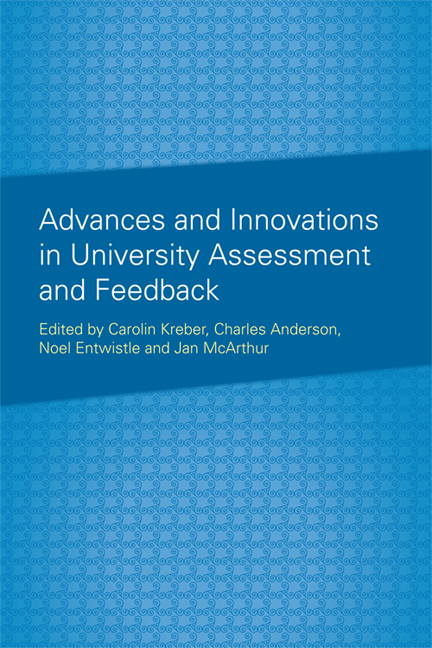Book contents
- Frontmatter
- Contents
- List of Tables and Figures
- Acknowledgements
- Foreword
- Introduction
- Part A Changing Perspectives on the Nature and Purposes of Assessment
- 1 Shifting Views of Assessment: From Secret Teachers' Business to Sustaining Learning
- 2 Flourishing amid Strangeness and Uncertainty: Exploring the Meaning of ‘Graduateness’ and its Challenges for Assessment
- 3 Assessment for Learning Environments: A Student-Centred Perspective
- Part B Students' Perceptions of Assessment and Feedback
- Part C Reconceptualising Important Facets of Assessment
- Part D Innovations in Assessment Practices
- Notes on the Contributors
- Index
3 - Assessment for Learning Environments: A Student-Centred Perspective
from Part A - Changing Perspectives on the Nature and Purposes of Assessment
Published online by Cambridge University Press: 05 August 2016
- Frontmatter
- Contents
- List of Tables and Figures
- Acknowledgements
- Foreword
- Introduction
- Part A Changing Perspectives on the Nature and Purposes of Assessment
- 1 Shifting Views of Assessment: From Secret Teachers' Business to Sustaining Learning
- 2 Flourishing amid Strangeness and Uncertainty: Exploring the Meaning of ‘Graduateness’ and its Challenges for Assessment
- 3 Assessment for Learning Environments: A Student-Centred Perspective
- Part B Students' Perceptions of Assessment and Feedback
- Part C Reconceptualising Important Facets of Assessment
- Part D Innovations in Assessment Practices
- Notes on the Contributors
- Index
Summary
Introduction
Assessment for learning is arguably the most widespread development in assessment practice in recent years. Many universities have introduced assessment for learning initiatives designed to enhance assessment and improve student learning. Some institutions focus on single specific aspects of assessment for learning, such as feedback to students on their work. Others have a broader scope, such as an aim to improve formative assessment using a range of methods. Although many policies, strategies and practices are centred on assessment for learning, it is not always clear on what basis the term is being used. Paul Black, a leading researcher and developer of assessment, claims that assessment for learning has become ‘a free brand name to attach to any practice’ (Black 2006, 11). It is not only that assessment for learning practices are varied, but the same is true when we examine the thinking behind assessment for learning, the underlying pedagogical approaches and philosophies and the nature of experiences offered to students. The varying views of assessment for learning can be located on a spectrum ranging from those based on assessment techniques, which use new assessment practices to manage student behaviour, to those that focus on transformations in learning environments to foster student engagement and self-directed learning. In this chapter, we examine different versions of assessment for learning and the student roles that they enable.
The Development of Assessment for Learning
Assessment has been moving to the forefront of higher education pedagogy for a number of years. Assessment now takes its place in the phrase ‘teaching, learning and assessment’ and it integrates these three components as a holistic practice. Birenbaum (1996) reflected on the changes in pedagogy linked to changes in assessment. The ‘old’ pedagogic approach, which she termed a ‘testing culture’, drew on behaviourist perspectives with assessment based fundamentally on testing and the measurement of how much of a defined, decontextualised body of knowledge students could remember or apply. This testing was typified by exams, where students faced unknown questions in a time-constrained context and without reference to any resources or guidance materials. In contrast, Birenbaum used the term ‘assessment culture’ to describe the new assessment that is integrated with learning and teaching and takes different forms, being more authentic, challenging and engaging for students and functioning as a learning activity as well as a means of demonstrating knowledge.
- Type
- Chapter
- Information
- Publisher: Edinburgh University PressPrint publication year: 2014



